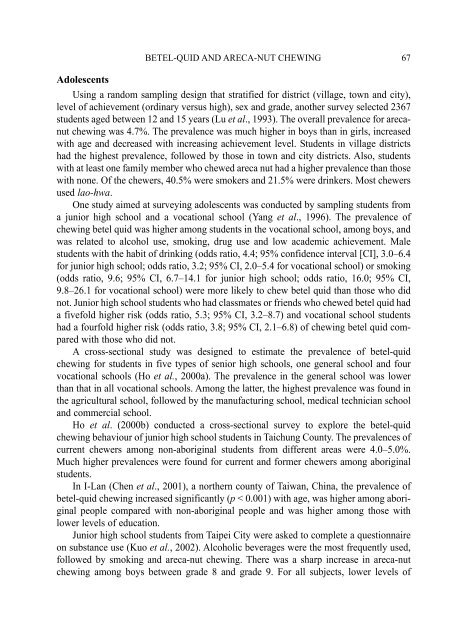BETEL-QUID AND ARECA-NUT CHEWING - IARC Monographs
BETEL-QUID AND ARECA-NUT CHEWING - IARC Monographs
BETEL-QUID AND ARECA-NUT CHEWING - IARC Monographs
Create successful ePaper yourself
Turn your PDF publications into a flip-book with our unique Google optimized e-Paper software.
Adolescents<br />
<strong>BETEL</strong>-<strong>QUID</strong> <strong>AND</strong> <strong>ARECA</strong>-<strong>NUT</strong> <strong>CHEWING</strong> 67<br />
Using a random sampling design that stratified for district (village, town and city),<br />
level of achievement (ordinary versus high), sex and grade, another survey selected 2367<br />
students aged between 12 and 15 years (Lu et al., 1993). The overall prevalence for arecanut<br />
chewing was 4.7%. The prevalence was much higher in boys than in girls, increased<br />
with age and decreased with increasing achievement level. Students in village districts<br />
had the highest prevalence, followed by those in town and city districts. Also, students<br />
with at least one family member who chewed areca nut had a higher prevalence than those<br />
with none. Of the chewers, 40.5% were smokers and 21.5% were drinkers. Most chewers<br />
used lao-hwa.<br />
One study aimed at surveying adolescents was conducted by sampling students from<br />
a junior high school and a vocational school (Yang et al., 1996). The prevalence of<br />
chewing betel quid was higher among students in the vocational school, among boys, and<br />
was related to alcohol use, smoking, drug use and low academic achievement. Male<br />
students with the habit of drinking (odds ratio, 4.4; 95% confidence interval [CI], 3.0–6.4<br />
for junior high school; odds ratio, 3.2; 95% CI, 2.0–5.4 for vocational school) or smoking<br />
(odds ratio, 9.6; 95% CI, 6.7–14.1 for junior high school; odds ratio, 16.0; 95% CI,<br />
9.8–26.1 for vocational school) were more likely to chew betel quid than those who did<br />
not. Junior high school students who had classmates or friends who chewed betel quid had<br />
a fivefold higher risk (odds ratio, 5.3; 95% CI, 3.2–8.7) and vocational school students<br />
had a fourfold higher risk (odds ratio, 3.8; 95% CI, 2.1–6.8) of chewing betel quid compared<br />
with those who did not.<br />
A cross-sectional study was designed to estimate the prevalence of betel-quid<br />
chewing for students in five types of senior high schools, one general school and four<br />
vocational schools (Ho et al., 2000a). The prevalence in the general school was lower<br />
than that in all vocational schools. Among the latter, the highest prevalence was found in<br />
the agricultural school, followed by the manufacturing school, medical technician school<br />
and commercial school.<br />
Ho et al. (2000b) conducted a cross-sectional survey to explore the betel-quid<br />
chewing behaviour of junior high school students in Taichung County. The prevalences of<br />
current chewers among non-aboriginal students from different areas were 4.0–5.0%.<br />
Much higher prevalences were found for current and former chewers among aboriginal<br />
students.<br />
In I-Lan (Chen et al., 2001), a northern county of Taiwan, China, the prevalence of<br />
betel-quid chewing increased significantly (p < 0.001) with age, was higher among aboriginal<br />
people compared with non-aboriginal people and was higher among those with<br />
lower levels of education.<br />
Junior high school students from Taipei City were asked to complete a questionnaire<br />
on substance use (Kuo et al., 2002). Alcoholic beverages were the most frequently used,<br />
followed by smoking and areca-nut chewing. There was a sharp increase in areca-nut<br />
chewing among boys between grade 8 and grade 9. For all subjects, lower levels of

















